|
|
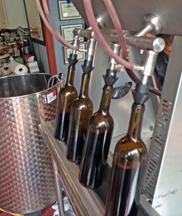 After almost 21 months in barrel, it was time to bottle our Atlas Peak AVA, Napa Valley Cabernet Sauvignon. We received the grapes from Stagecoach Vineyards on October 20th, 2012. After destemming and placing the grapes in a fermentation bin, we selected a yeast to add to the grapes. During the week of fermentation we also added malolactic bacteria. We decided to extract more color and flavor with a post fermentation maceration. We pressed and racked to a Taransaud barrel on November 12th. Other than a racking off the gross lees, the wine has been in our new French oak barrel for almost 21 months. It was time to bottle. After almost 21 months in barrel, it was time to bottle our Atlas Peak AVA, Napa Valley Cabernet Sauvignon. We received the grapes from Stagecoach Vineyards on October 20th, 2012. After destemming and placing the grapes in a fermentation bin, we selected a yeast to add to the grapes. During the week of fermentation we also added malolactic bacteria. We decided to extract more color and flavor with a post fermentation maceration. We pressed and racked to a Taransaud barrel on November 12th. Other than a racking off the gross lees, the wine has been in our new French oak barrel for almost 21 months. It was time to bottle.
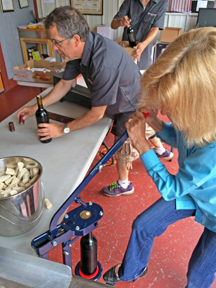 Dave Zuchero had the bottling line set up at Tin Lizzie Wineworks in Clarksville, Maryland. We arrived early on Sunday morning. Dave already racked the wine from our barrel to a stainless steel tank. He then cleaned and sulfured the barrel; we will use the barrel again this fall for another wine. Tin Lizzie has a four prong bottler. You simply slip a bottle under a prong and it automatically shuts off when filled. I took this station, filled the bottles and passed them of to the corkers. Kathy was at one of the two corking stations and corked half of the bottles. The corkers were heavy duty corkers, the heavy duty type that can be operated with one hand a just a little force. We have one of these at home that I use to cork the wine we make at home while Kathy fills the bottles. We reversed rolls at Tin Lizzie. Dave Zuchero had the bottling line set up at Tin Lizzie Wineworks in Clarksville, Maryland. We arrived early on Sunday morning. Dave already racked the wine from our barrel to a stainless steel tank. He then cleaned and sulfured the barrel; we will use the barrel again this fall for another wine. Tin Lizzie has a four prong bottler. You simply slip a bottle under a prong and it automatically shuts off when filled. I took this station, filled the bottles and passed them of to the corkers. Kathy was at one of the two corking stations and corked half of the bottles. The corkers were heavy duty corkers, the heavy duty type that can be operated with one hand a just a little force. We have one of these at home that I use to cork the wine we make at home while Kathy fills the bottles. We reversed rolls at Tin Lizzie.
Another winery worker placed the capsules on the bottles and heated them. As was the case three years ago when we bottled our 2009 Cabernet Sauvignon/Merlot at Tin Lizzie, the weather was too humid for the bottle labels to easily affix to the bottles. This will be an at home task. With help from the winery staff, we were able to pack 24 cases into our car for the ride home. We are now in the process of affixing the labels and storing the wine in our wine room.
Many people would find the bottling process exciting. The thrill of the event has worn off for us though. We have bottled wine at a winery in Virginia, Maryland, the country Georgia and bottled wine at home. It now isn’t that exciting, just another task in the entire winemaking process. It does signify a timeline point for the wine that will continue to age until opened. We expect the wine to age a number of years, two to seven, before it reaches its “Wow! This is really good” point. We learned from our 2009 Paso Robles Cabernet Sauvignon to be patient. That wine changed monthly in the bottle for the first year. It continues to change and has reached it “This is really good” point. We will open a bottle of our 2012 Cab once every four to six months just to see how it is doing. Fortunately, we have the patience for the wine to bottle age for a number of years.
To read more about our wine check out the wine’s webpage.
Cheers,
Terry
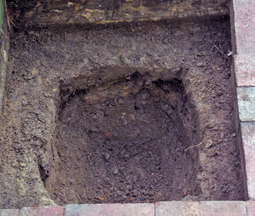 On our visit to the country Georgia last September, our driver laughed at us because we wanted to see a hole in the ground. Both Kathy, myself and two apprentice winemakers, one from Austria and the other from Ukraine were excited to see a hole in the ground. However, those laughing or smiling did not see what we saw. Rather than seeing the site for what it was, we saw the site for what it would someday become. We saw a marani with several qvevri buried and a winemaker making wines in the traditional Georgian method that has now been added to the UNESCO list of Cultural Heritage. On our visit to the country Georgia last September, our driver laughed at us because we wanted to see a hole in the ground. Both Kathy, myself and two apprentice winemakers, one from Austria and the other from Ukraine were excited to see a hole in the ground. However, those laughing or smiling did not see what we saw. Rather than seeing the site for what it was, we saw the site for what it would someday become. We saw a marani with several qvevri buried and a winemaker making wines in the traditional Georgian method that has now been added to the UNESCO list of Cultural Heritage.
I brought back a qvevri to the United States from Georgia when we visited this spring. It is not large, just 24 liters. I’ve considered different things to do with it. Such as build a frame and keep it in the house. That way I could make wine in it and talk about the ancient Georgian winemaking process. However, common sense prevailed and I ended up digging a hole in the ground. I did not have to dig very deep, just deep enough to completely bury the qvevri under a few inches of soil.
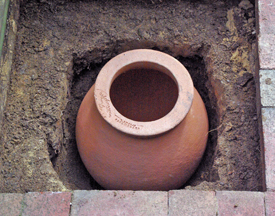 So now I have a hole in the ground. When I look at it though, I see the potential of making a qvevri wine. I see nature’s cooling jacket where the ground temperature will remain somewhat constant during the months wine is aging in the qvevri. Just to give an idea, I photographed the qvevri in the hole. It is actually several inches below the surface. Before burying it I have to slowly heat the qvevri to 70ºC and coat the inside with beeswax that is heated to 110ºC. The beeswax will seal the pours of the vessel and provide some help with keeping bacteria out of the wine. Then I will bury the qvevri and search for a source of Viognier grapes. So now I have a hole in the ground. When I look at it though, I see the potential of making a qvevri wine. I see nature’s cooling jacket where the ground temperature will remain somewhat constant during the months wine is aging in the qvevri. Just to give an idea, I photographed the qvevri in the hole. It is actually several inches below the surface. Before burying it I have to slowly heat the qvevri to 70ºC and coat the inside with beeswax that is heated to 110ºC. The beeswax will seal the pours of the vessel and provide some help with keeping bacteria out of the wine. Then I will bury the qvevri and search for a source of Viognier grapes.
Cheers,
Terry
The vines are behind last year. Last year, 2013, the vines were behind the previous year. We are in our 16th straight month in which our average monthly temperature is below where the average monthly temperature was the previous year. Grapevines can show this quite well. I took a photo of my vines today, the 20th of April. Compare of it to a photo from last year, also taken on April 20th. How long is a long winter’s nap?
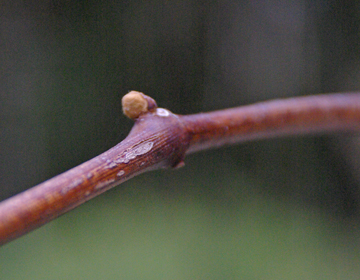 April 20, 2014 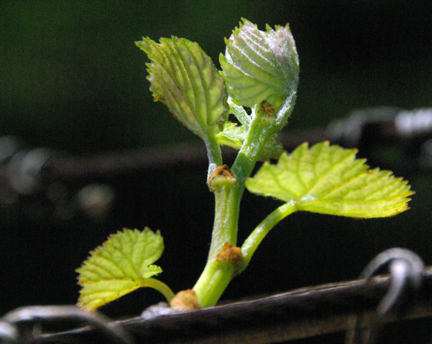 April 20, 2013 Cheers,
Terry
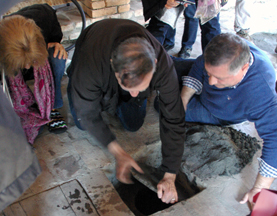 Once upon a time, thousands and thousands of years ago, earthen vessels resembling qvevri were used to bury people in a sitting position. Sealed in an earthen vessel and buried underground seems so final. However with wine, it is representative of birth. Once upon a time, thousands and thousands of years ago, earthen vessels resembling qvevri were used to bury people in a sitting position. Sealed in an earthen vessel and buried underground seems so final. However with wine, it is representative of birth.
This is what it was like for Rkatsiteli, buried in a qvevri under the ground for the past six months. Death came to yeast cells that fell to the bottom of the qvevri. Skins and seeds fell next, but a clear wine remained on top awaiting for its birth. Yesterday, we returned to Twins Wine Cellar in Napareuli to open our qvevri. After removing black sand, the tomb’s lid was removed. At least it resembled a tomb’s lid. Held tightly to the qvevri opening by clay and suction, the lid loosened after some pressure was applied. The wine was greeted by daylight and the birth took place.
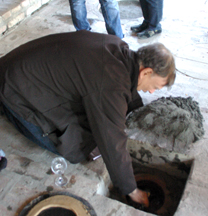 Terry fills a glass with a tasting of the qvevri wine. Gently stirring the wine, a glass was then filled with a tasting. The yellow colored qvevri wine was tasted for the first time. The color was clear as though the wine had been filtered. However, no filtering took place other than the natural filtering of the earthen winemaking vessel. Floral and tropical fruit aroused the nose and mouth. There was a crisp finish and mild tannins, the result of the skins and seeds contact for several months. Others in the media group attending the qvevri opening were pleased with the wine, a lighter body with less tannins than some of the amber colored qvevri white wines tasted in Georgia.
This natural wine had no winemaking supplies added to it, including commercial yeasts. Fermentation took place with the natural yeasts that were present in the vineyard. No other winemaking supplies were added. From the qvevri the wine was bottled and corked. Time will tell how well the wine will handle transportation of 6,500 miles and bottle aging prior to opening. Our first opening of a qvevri wine was a special occurrence not unlike a birth.
Cheers,
Terry
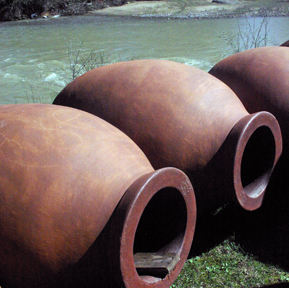 Although larger than the qvevri purchased, Zaliko Bodjadze’s qvevris rest in a peaceful place. After wishing and planning, I purchased a qvevri while in Western, Georgia. I’ll have to measure the size of the qvevri when I get it back to Maryland; however, it looks to be about 20 liters. The qvevri was not waxed, so I will also have to coat it with bees wax when I return home. Kathy’s brother owns an apiary in Upstate New York, so obtaining a quality beeswax is not a challenge.
I bought the qvevri from Zaliko Bodjadze near the village of Makatubani. It is rumored that Zaliko is one of the best qvevri makers in Georgia. There are few potters making qvevri in Georgia. Hopefully with qvevri making being added to the UNESCO list of intangible cultural heritage, the number of qvevri makers will increase.
My next challenge is to get the qvevri back to Maryland in one piece. At 20 liters, this qvevri may be small enough to wrap in bubble wrap and take as a carry-on. It will easily fit in the overhead bins or under the seat in front of us. I think carry-on may be a little safer than checking it in or putting it inside a suitcase.
Early plans are to purchase some Viognier grapes. I will place some of the grapes in the qvevri while the rest of the grapes will be placed in a fermentation bin. After fermentation I will rack the wine from the fermentation bin and use it to top off the qvevri. I will then have to determine how I want to seal the qvevri. Early thought, subject to change, is to place a coil of clay around the top of the qvevri and seal it with slate or a custom cut thick piece of glass. Next March I will open the qvevri, rack the wine and bottle.
This will be my first attempt of making wine using ancient technology from start to finish. Kathy and I did help to make a qvevri wine at Twins Wine Cellar in Napareuli, Georgia. This will be our first attempt back in the states.
Shopping for a qvevri is done. Next is to purchase a cherry bark brush, used to clean qvevris.
Cheers,
Terry
Vineyards are magical during the winter. Although many people love to see bunches of grapes hanging from the vines, in the Northern Hemisphere winter affords other romantic views of vineyards. We were hit with ice and for a few hours the vineyards turned into a beautiful diamond scene. This doesn’t happen every year. I braved the slippery conditions to walk the 30 feet to my vines to capture a couple photos before Mother Nature warms and takes away the beautiful scene.
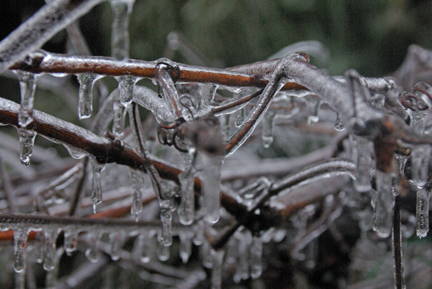 Covered in ice after a February ice storm. 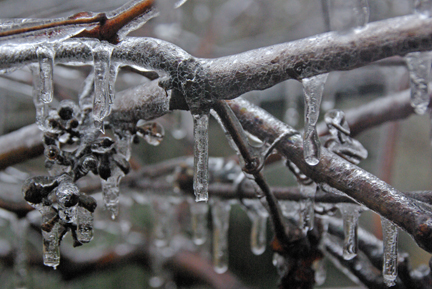 The beauty of a vineyard during winter. Cheers,
Terry
Now that we are nearing the end of 2013, it is a time for reflection. One of the things that I have been pondering is the first wine that my wife, Kathy, and I made. In late 2007 we decided that if we were going to write about wine, we should make wine. Kathy gave me a winemaking kit for Christmas 2007. It sat unopened until the middle of 2008. To best describe the wine we made, I would use the word “plonk.” After the fact, winemakers made suggestions. The one that worked the best was to pour about two inches of port into a decanter than fill with the Cabernet Sauvignon that we made. However, I should point out that other winemakers argued, “Why ruin the port?”
Making our first wine from a kit did teach us some lessons. The first was regarding kits in general. You get what you pay for. A kit that cost $70 for the juice is not going to provide the same quality as a kit priced over $200. The second lesson is that we did learn something about winemaking. Our second wine we made in 2008 was a mead. We made it from scratch.
We did go on to make two other kit wines. In 2009 we made a Riesling Icewine-style wine. We learned that sugar is a winemakers secret weapon. It can also cover up some faults. Then in 2011 we made a Sauvignon Blanc from a kit that sourced the juice from the Marlborough wine region in New Zealand. This was an expensive kit and we were quite pleased with the results.
What was your experience making your first wine?
Cheers,
Terry
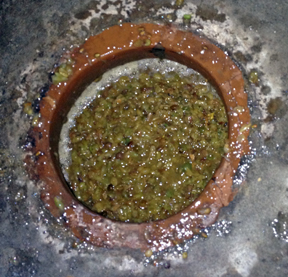 Rkatsiteli in qvevri with juice and chacha Qvevri are earthen vessels crafted from clay, fired, coated on the inside with beeswax, often coated on the outside with cement and buried in the ground. Sizes range from one liter to thousands of liters. Compared to other winemaking vessels, qvevri are relatively inexpensive. For example, two qvevri craftsmen in Georgia charge about one dollar per liter. An oak barrel is 225 liters and if it is a French oak barrel can cost $1,000 or more. A 225 liter qvevri would cost $225 plus shipping.
Oak barrels are often used from three to five years. Qvevri are often used for hundreds of years. This ability to reuse a qvevri for centuries makes it the most economical vessel for making wine. We have visited winemakers that are still using qvevri crafted two centuries ago. We discovered that there are different winemaking protocols for making qvevri wine.
Some winemakers place whole grape clusters in the qvevri to ferment and age. The more popular practice is to press the grapes in a wood press using your feet. The grape juice and the chacha (skins, seeds and stems) are placed in the qvevri with the juice to ferment and age. Other winemakers use modern destemmer to destem the grapes and place the juice and chacha into the qvevri. Some producers add all the chacha to the qvevri while others add only a percentage of the chacha to the juice in a qvevri. Then there are a few producers that press the grapes and only add the juice to the qvevri.
Fermentation is done with the native yeasts. We asked if there were enough yeast to ferment the juice if only juice were added to a qvevri. The winemakers using this technique said the always had the juice ferment. After fermentation the techniques also vary. Some winemakers rack the wine into another qvevri without the chacha. While other winemakers seal the original qvevri letting the wine on its chacha. They usually let the wine on the chacha for six months. After which they may rack to another qvevri to help with clarification.
There isn’t one protocol that all winemakers making wine in qvevri follow. As a result, the wines will show different colors as well as aromas, tastes and tannins. A white wine made from only the juice in the qvevri will be a yellow color and probably floral and fruity with no tannins. A white wine fermented and aged on its chacha for six months will be an dark gold or amber color, have more intense aromas and tastes and have mild to bold tannins.
Consumers that want a qvevri made wine for a reason such as a white wine with bold tannins, need to know about the producer and the procedures the winemaker followed.
Cheers
Terry
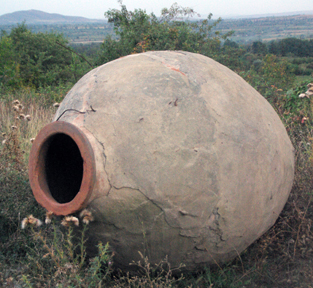 Some people, especially when they first taste a qvevri wine, think they are tasting the qvevri. This is similar to tasting what an oak barrel imparts to the wine if aged. However unlike other vessels for fermenting and aging wines, qvevri do not impart aromas and tastes to the wine. Why not? Some people, especially when they first taste a qvevri wine, think they are tasting the qvevri. This is similar to tasting what an oak barrel imparts to the wine if aged. However unlike other vessels for fermenting and aging wines, qvevri do not impart aromas and tastes to the wine. Why not?
After the qvevri is fired, it begins to cool down. When it reaches 70ºC (150ºF) melted beeswax is spread throughout the inside of the qvevri. The beeswax is absorbed into the pours of the qvevri and acts to seal the surface. The beeswax also has the property of killing any bacteria that may be present. During fermentation and aging, the wine does not pick up any aromas or tastes from the qvevri.
We asked if this beeswax technology would work with other winemaking vessels. Answers were mixed. However, most think it would not. A qvevri needs to be at the 70ºC stage in order to get optimal absorption of the beeswax. I wondered about the cement vats we saw earlier in France. These vats were either coated with epoxy or left untreated. In either case there is some imparting of aromas or tastes to the wines, although imperceptible to many.
Why do some qvevri wine tasters think they taste the qvevri? They are actually smelling and tasting the effect of fermenting the juice on its chacha (grape skins, seeds and sometimes stems). These items add flavor and aromas to the wines. Although red wines traditionally are fermented on the grapes’ skins, seeds and perhaps stems, it is the white wines that surprise people. Many qvevri white wines are gold to dark amber in color. They have mild tannins to bold tannins. This surprises people that have a notion of what a white wine should look, smell and taste like. If you have an opportunity to taste a qvevri made wine, taste a natural wine that has picked up aromas and tastes from the entire grape, not the qvevri.
Cheers,
Terry
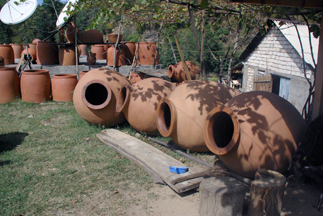 There is some discussion amongst winemakers in Georgia on whether a Georgian traditional wine made in qvevri should be referred to as a qvevri wine or a natural wine. Those in the natural wine court are beginning to become more vocal. There is a difference in the two, although to many the two terms “qvevri wine” and “natural wine” are synonymous. A qvevri wine could be a natural wine, but not always. A wine not made in a qvevri could also be a natural wine. So what is a natural wine? There is some discussion amongst winemakers in Georgia on whether a Georgian traditional wine made in qvevri should be referred to as a qvevri wine or a natural wine. Those in the natural wine court are beginning to become more vocal. There is a difference in the two, although to many the two terms “qvevri wine” and “natural wine” are synonymous. A qvevri wine could be a natural wine, but not always. A wine not made in a qvevri could also be a natural wine. So what is a natural wine?
A natural wine is a wine that allows the grapes to express themselves without adding things during fermentation and aging. Wait, winemakers add things to a wine? Yes, quite a bit! For example, last autumn when we made our Cabernet Sauvignon at Tin Lizzie Wineworks, we added potassium metabisulfite, yeast, yeast nutrients, Lallemand Booster Rouge, Lallzyme EX-V™ an enzyme, and Scott’tan FT Rouge. You get the idea, we added stuff to the wine. In contrast, our qvevri wine we are making at Twins Wine Cellar in Napareuli had nothing added. No yeasts, no indigenous yeast inhibitors, not yeast nutrition, no color enhancers and no phenolic enhancers. Which wine do you think is more natural? Which wine do you think allows the grape to express itself?
Later we put our Cabernet Sauvignon in a new French oak barrel. The wine will extract color, tannins and flavors from the oak barrel, hopefully without tasting like a piece of wood. A wine made in qvevri does not pick up anything on the aroma or taste from the qvevri. There are some wine tasters that claim they can taste the qvevri. However, they should say that they taste the effect that the skins, seeds and possibly stems have on a wine through fermentation and extended maceration that can last for months.
So it looks like qvevri winemakers have more of a claim of making natural wine than non-qvevri winemakers. Some are quick to point out that a qvevri is only a vessel used during fermentation and aging. It is the process of not adding anything to a wine that makes it a natural wine. Which brings us to the question, are all qvevri wines natural wines? Not if the winemaker adds anything to the wine. We have not met many Georgian winemakers that admitted that they add things to their qvevri wine. But they did tell us that some do.
One question that we have asked Georgian winemakers is if they have ever had a stuck fermentation in their qvevri. The resounding answer is never. They have no problem with the native yeasts fermenting the wine. Perhaps growing vineyards and making wine for 8,000 yeas has helped cause an abundance of native yeasts.
Cheers,
Terry
|
|
 After almost 21 months in barrel, it was time to bottle our Atlas Peak AVA, Napa Valley Cabernet Sauvignon. We received the grapes from Stagecoach Vineyards on October 20th, 2012. After destemming and placing the grapes in a fermentation bin, we selected a yeast to add to the grapes. During the week of fermentation we also added malolactic bacteria. We decided to extract more color and flavor with a post fermentation maceration. We pressed and racked to a Taransaud barrel on November 12th. Other than a racking off the gross lees, the wine has been in our new French oak barrel for almost 21 months. It was time to bottle.
After almost 21 months in barrel, it was time to bottle our Atlas Peak AVA, Napa Valley Cabernet Sauvignon. We received the grapes from Stagecoach Vineyards on October 20th, 2012. After destemming and placing the grapes in a fermentation bin, we selected a yeast to add to the grapes. During the week of fermentation we also added malolactic bacteria. We decided to extract more color and flavor with a post fermentation maceration. We pressed and racked to a Taransaud barrel on November 12th. Other than a racking off the gross lees, the wine has been in our new French oak barrel for almost 21 months. It was time to bottle. Dave Zuchero had the bottling line set up at Tin Lizzie Wineworks in Clarksville, Maryland. We arrived early on Sunday morning. Dave already racked the wine from our barrel to a stainless steel tank. He then cleaned and sulfured the barrel; we will use the barrel again this fall for another wine. Tin Lizzie has a four prong bottler. You simply slip a bottle under a prong and it automatically shuts off when filled. I took this station, filled the bottles and passed them of to the corkers. Kathy was at one of the two corking stations and corked half of the bottles. The corkers were heavy duty corkers, the heavy duty type that can be operated with one hand a just a little force. We have one of these at home that I use to cork the wine we make at home while Kathy fills the bottles. We reversed rolls at Tin Lizzie.
Dave Zuchero had the bottling line set up at Tin Lizzie Wineworks in Clarksville, Maryland. We arrived early on Sunday morning. Dave already racked the wine from our barrel to a stainless steel tank. He then cleaned and sulfured the barrel; we will use the barrel again this fall for another wine. Tin Lizzie has a four prong bottler. You simply slip a bottle under a prong and it automatically shuts off when filled. I took this station, filled the bottles and passed them of to the corkers. Kathy was at one of the two corking stations and corked half of the bottles. The corkers were heavy duty corkers, the heavy duty type that can be operated with one hand a just a little force. We have one of these at home that I use to cork the wine we make at home while Kathy fills the bottles. We reversed rolls at Tin Lizzie.













